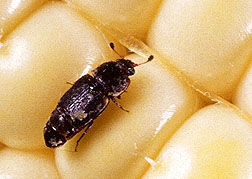This page has been archived and is being provided for reference purposes only. The page is no longer being updated, and therefore, links on the page may be invalid.
|
|
Sap Beetles’ Attractant Aids ControlBy Ben HardinMarch 3, 1997 Decisions on whether to apply insecticides to peach, apricot and other crops might be made easier by keeping tabs on the weather and monitoring sap beetle populations using traps containing synthetic versions of natural chemical attractants. By cutting out unnecessary chemical use, growers could help preserve the environment as well as their profit margin. The attractants first synthesized and patented by scientists of USDA’s Agricultural Research Service were used by entomologists of ARS and New South Wales Agriculture in a five-year study in Australia. Sap beetles are found throughout the world and spread fruit-degrading fungi in a wide variety of crops. ARS scientists with other scientists around the world are studying ways to use attractants for environmentally friendly control of sap beetles in stored cacao and a wide variety of crops including figs, plums, pineapples and corn. One insect species trapped in the study was the confused sap beetle, Carpophilusmutilatus, also found in the United States. This species is believed to normally destroy about 10 percent of deglet noor dates in California and sometimes much larger portions of the bigger and more expensive medjool dates. The Australian researchers found minimal insect damage to stone fruit crops in years when lower-than-normal midsummer rainfall caused beetle populations to plummet and remain low until harvest. ARS is seeking more cooperators to speed development of sap beetle attractants in the United States. Scientific contact: Robert J. Bartelt, USDA-ARS, National Center for Agricultural Utilization Research, Peoria, Ill., phone (309)681-6237, e-mail bartelrj@ncaur1.ncaur.gov |

